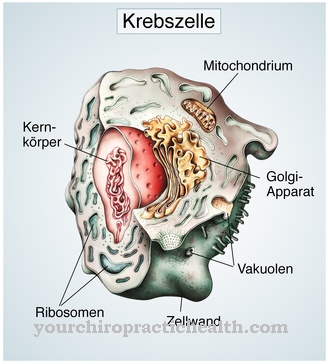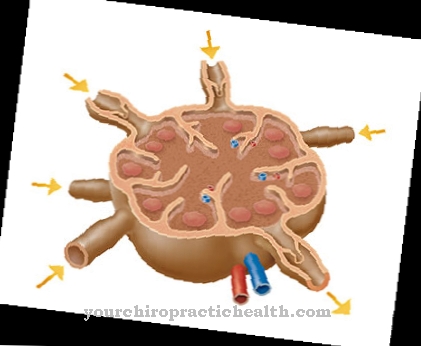The acute myeloid leukemia, often with AML abbreviated, is a particularly insidious and rapidly spreading form of blood cancer that often affects children as well. About every third cancer finding in adolescents and small children can be traced back to leukemia, with acute myeloid leukemia being the second most common of these diagnosed leukemias.
What is Acute Myeloid Leukemia?

Leukemia means "white blood" and describes the uncontrolled spread of unfinished white blood cells, the so-called leukocytes, in the blood and the associated suppression of red blood cells (erythrocytes), blood platelets (thrombocytes) and finished white blood cells.
Acute myeloid leukemia takes its name from its rapid and aggressive - or "acute" - course as well as from the biological classification of its progenitor cells, which are called "myeloid".
causes
The causes for the development of acute myeloid leukemia are still largely unexplored. It is only clear that certain environmental factors, such as frequent contact with harmful substances, such as benzene, which e.g. occurs in gasoline or when certain materials are burned, such as car tires or wood.
This then leads to malignant changes in cells, which can lead to cancer. Cigarette smoke also contains a small amount of benzene.
Furthermore, certain viral infections, medication and a genetic predisposition are associated with the development of acute myeloid leukemia. To what extent a disease arises from these factors is still unclear.
Symptoms, ailments & signs
Acute myeloid leukemia occurs suddenly and very quickly leads to severe disease courses. If left untreated, death can occur within a few weeks from uncontrollable infections or bleeding. However, treatment works so well in around two-thirds of those affected that there is a complete chance of recovery for 20 percent of patients.
The symptoms that appear suddenly are caused by the rapid increase in immature leukocytes, which hinder the formation of normal blood cells such as erythrocytes, functional granulocytes and platelets. The lack of erythrocytes causes anemia. The lack of functional granulocytes leads to a weakening of the immune system and thus to infectious diseases that are difficult to control.
The loss of platelets reduces the ability of the blood to clot and thereby increases the risk of severe bleeding. The illness begins with a sudden onset of fever, feeling very sick, paleness, night sweats and often severe shortness of breath. Furthermore, hematomas as well as skin, mucous membrane and gum bleeding occur constantly.
Serious infections of the lungs and other organs are often observed. Tonsillitis and unexplained fever are also typical symptoms. The lining of the mouth is very often inflamed. In addition, a fungal infection of the mouth (oral thrush) can occur.
In rarer cases there is swelling of the lymph nodes and gums. The spleen or liver may also be enlarged. Although the treatment is working very well, not all cancer cells can be removed in many patients. This often leads to a relapse after several years.
Diagnosis & course
Acute myeloid leukemia is insidious and initially only manifests itself slightly. The initial symptoms, such as exhaustion, tiredness, fever, heavy night sweats, swelling of the lymph nodes or abdominal pain, are often confused with those of a simple cold or flu and are therefore initially underestimated and not correctly assigned.
Early diagnosis and rapid treatment are particularly important in acute myeloid leukemia, because the immature cells otherwise spread extremely quickly in the human organism and can damage the liver, spleen and other important organs of the body after just a few weeks.
In addition, the rapid increase in leukocytes in the bone marrow can lead to pain in the bones, as well as reduced blood clotting - as a result of the loss of red blood cells - to bruises and nosebleeds. If the acute myeloid leukemia remains untreated, it inevitably leads to the death of the affected patient within a few months.
Doctors can detect acute myeloid leukemia either by evaluating a blood count, examining the bone marrow for structural abnormalities, or by chemically analyzing a blood sample for abnormal coagulation values and inflammation parameters.
When should you go to the doctor?
Acute leukemia is rapid and fatal if left untreated. As soon as the diagnosis is made, which is usually done by a doctor and various examination methods, the further procedure is either explained to the patient directly or a referral to a local oncologist or specialist clinic follows. Quick action is required for recovery and therapeutic measures must be initiated immediately.
Self-treatment without medical assistance or spontaneous healing of the disease without suitable therapy is not possible. Alternative healing methods are always recommended if they take place or are used in parallel with cancer therapy.
However, they cannot represent the sole therapy. Those affected should take the diagnosis very seriously and should not wait long to start therapy, even if this represents a great burden and life change. Timely treatment is of great importance for remission. The further the disease can progress untreated, the worse the chances of a complete cure.
Therefore, the following applies here: See a doctor immediately and start further treatment measures!
Doctors & therapists in your area
Treatment & Therapy
Around 50 years ago, acute myeloid leukemia was practically incurable and the survival rate of those affected was almost zero. Nowadays, however, conventional medicine is a big step further and can point to a cure rate of over 50 percent in patients who become ill before the age of 60.
In children it is even a good bit higher at 70 percent. In contrast, only 20 percent of patients who become ill after their 60th year of life. By surveying clinical studies, the treatment has been made more effective, more individual and more promising bit by bit in the last few decades. With the help of new diagnostic methods, acute myeloid leukemia can now also be detected more quickly and more accurately, which can be essential for a possible cure.
A therapy always consists of four therapy cycles that begin immediately after the diagnosis. In the first two cycles, "induction chemotherapy" is used to try to curb the development and spread of the diseased cells and, if possible, to stop them completely so that the disease (in the best case) can no longer be detected in the body.
Subsequently, in two further cycles and by renewed chemotherapy, a return of the leukocytes and thus a repeated outbreak of acute myeloid leukemia should be prevented.
prevention
Acute myeloid leukemia can currently only be prevented indirectly. Quitting smoking and other pollutants can help prevent cancer from developing in the first place. A healthy life, a conscious and healthy diet, as well as plenty of sport and exercise also help to keep the risk of leukemia low.
You can do that yourself
The reduction in erythrocytes leads to fatigue. For those affected, it is advisable to start the day slowly and with a few strong breaths. Slow movements enable the body to reproduce erythrocytes more easily. Efforts such as carrying heavy shopping bags should be avoided. Glimpses of weakness, especially during the work routine, can be reduced with many small breaks.
Feeling unwell is a common symptom. This can be counteracted with light massages. It helps those affected if they run their hands over arms and legs. Promoting blood circulation in the feet requires more effort; a massage roller is recommended for them. The feet carry the entire body weight and are therefore particularly stressed. The lack of erythrocytes weakens the immune system, respiratory problems and febrile symptoms are the result. A well-kept home is therefore essential.
During leisure time, light sporting activities are permitted, with the exception of swimming. Simple gymnastic exercises or short bike rides improve your health. Relaxed stays in the fresh air encourage the formation of erythrocytes. Walks in wet weather are not recommended. Dry climatic zones are to be chosen for the vacation. A mildly tempered bedroom provides relief from night sweats. Fresh nightwear to change and frequent bed making make this side effect more bearable.


.jpg)
.jpg)


.jpg)




















